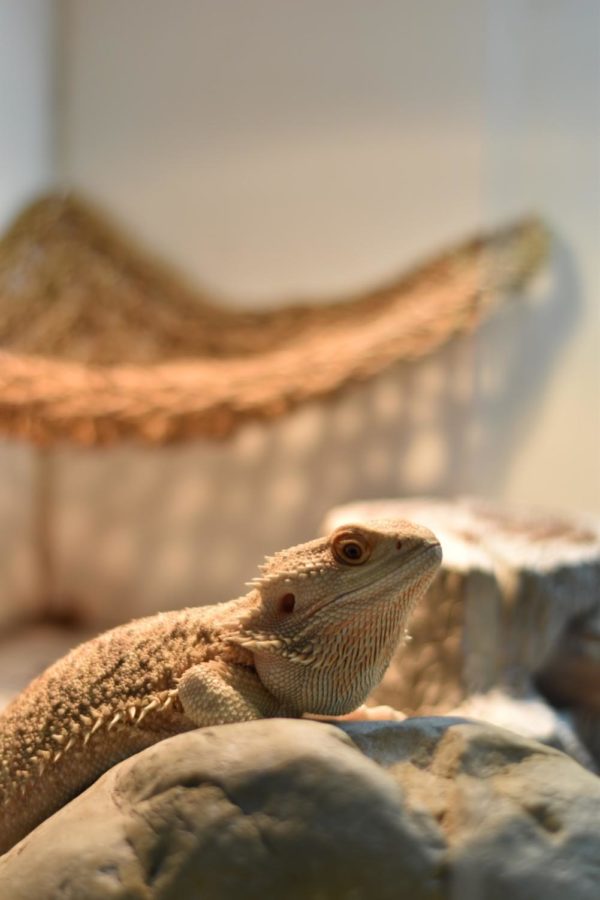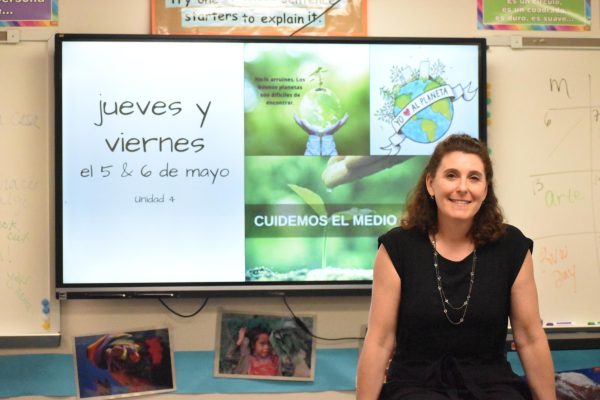Friends of the classroom
Class pets play an important role in helping students and teachers
Class pet Cheeto sits in her cage in Frantz’s class on Jan. 26. Cheeto can be brought out of her cage to interact with students as a reward for completing work.
Two small tanks sit on science teacher Rachel Brunsell’s desk, stacked atop each other. Her room, which has held a plethora of animals, including a chinchilla, tree frogs, hamsters, rats and a corn snake, is now home to a handful of Madagascar hissing cockroaches and a curly-haired tarantula named Charlotte.
“I used to have a million pets and then I had children, so I stopped having pets,” Brunsell said. “But these are both low-effort animals, I can handle these guys.”
While SHS has had many teachers with class pets, there continues to be many benefits from their place in the classroom.
Brunsell’s current class pets were both from the Reptile Expo at the Indiana state fairgrounds. The Reptile Expo happens once every few months, and they have a vast variety of reptiles, insects and exotic animals.
The cockroaches, which don’t have names, are still very young, which means Brunsell is not yet able to tell if they are male or female. Once they get older, the cockroaches will also hiss when disturbed as a defense mechanism. Charlotte is only a little over a year old, and will most likely live to be 30 years old.
While these animals spend their days inside the classroom, there are exceptions. On weekends, they stay in the classroom by themselves, but on breaks, they go home with Brunsell. Charlotte needs to be fed once a week and both animals need water, so care is necessary over those two weeks.
“(The cockroaches) could probably handle the two week break, but I feed her at least once a week,” Brunsell said. “And they need water. A lot of people forget that insects still need water.”
Like Brunsell, science teacher Rachel Frantz also has a class pet. Last year, she had a rat named Stitch, and this year, a bearded dragon named Cheeto.
At first, Frantz wasn’t even planning on having a class pet. Stitch originally belonged to Master Teacher Julie Conrad’s daughter, who was moving to IU to be a resident advisor, or RA. Once she moved, the rat needed a new home, and Frantz volunteered to take him.
“Stitch was an awesome first class pet,” Frantz said. “I was a little scared of him at first, to be honest, but he definitely grew on me. He was a very kind little nugget.”
Over the summer, Stitch passed away of old age. Due to the benefits she had seen with Stitch in the classroom, Frantz wanted another class pet.
Even though she had liked having a rat, Frantz did not want another one. Instead, she looked for other classroom-friendly pets.
“I wanted to have another class pet but I didn’t want another rat, because I didn’t want to buy a rat,” Frantz said. “I didn’t want to.”
A friend of Frantz’s recommended getting a bearded dragon, due to their eagerness to be handled and how easy they are to care for. Deciding to get a bearded dragon for herself, Frantz bought Cheeto, who is now about two years old, off of Craigslist.
Unlike Brunsell, Frantz does not take her pets home over the breaks. Because she travels often, it wouldn’t be helpful for the pets to stay with her. Instead, a student takes the pet home with them for the two weeks.
“Usually, I just check with their adults at home to make sure they’re okay with having a reptile for a week or two,” Frantz said. “I have a dog at home and since my family’s not from here, I leave, so she has to go with a petsitter.”
Since both Brunsell and Frantz’s animals live in their classrooms the majority of the school year, students can interact with them daily. While they make sure to never force their animals on anyone, students still have very mixed feelings about each pet.
“Some love it and some hate it. That’s why I keep them with me on the desk,” Brunsell said. “But some think it’s cool, and they like them.”
If a student especially likes one of her animals, Brunsell will allow them to touch it. Once their work is done, students are allowed to hold the cockroaches.
When holding the cockroaches, students must be sure to stay observant. According to Brunsell, the cockroaches will either lay very still in someone’s hands or try to get away, so keeping an eye on them is very important.
“They can go from standing still to fast quickly, so just pay attention,” Brunsell said.
Since Charlotte is delicate, students can only pet her, not hold her. Once Charlotte gets more acclimated to people, Brunsell will most likely let students hold her, as long as they do it properly.
Frantz’s students also have mixed feelings about Cheeto. While some love her, some do not like reptiles in general. Frantz believes that students with the same opinion about Cheeto often bond.
Students that like Cheeto are allowed to hold her, just like Brunsell’s cockroaches. While Cheeto is not extremely fragile, she has easily breakable nails. Additionally, she cannot breathe if she is put on her back, which means students must be sure to hold her a certain way.
While these animals evoke different emotions in each student, pets can be beneficial in lowering blood pressure, according to the American Heart Association. Frantz feels that if a student is not comfortable in their environment, they are not going to learn. To her, having a class pet helps create a more relaxed environment for students.
“I tend to do better learning-wise and engagement-wise and involvement-wise when I’m calm, and animals, I think, have a really calming effect on a lot of students,” Frantz said.
Spending time with Cheeto can also have positive effects on the individual student. According to Frantz, holding Cheeto can motivate students to get their work done. Her relaxed nature also brings comfort to a lot of students, as Stitch did.
“They truly are little therapy animals,” Frantz said. “They calm people down pretty easily.”
Sophomore Seven Martin has experienced the positive effects of a class pet firsthand. They were a biology student of Frantz’s last year, and a chemistry student of Frantz’s now, which means they have experiences with both Stitch and Cheeto. Having a class pet, they believe, makes the class more memorable, as well as more exciting to go to.
“Even if you’re not doing well in the class, it still gives you an incentive to come to the class,” Martin said.
While Brunsell’s pets may not have the same effects on students Stitch and Cheeto did, she has seen other benefits. The promise of getting to hold a pet when they have completed their work has increased a few students’ motivation levels.
“I’ve had more than one student in the past, (that) when they found out they could hold the tarantula or the cockroaches once their work was done, all of a sudden all the work is getting done,” Brunsell said.
While Brunsell has felt a love for animals and the environment for a long time, her students may not feel the same way. But, her class pets may change this, as they are a way to help students appreciate the world around them.
“Being an environmental science class, I think it’s important to communicate (that) we need to appreciate all species on this earth,” Brunsell said, “not just the ones we might find cute or cuddly.”
With all the benefits they’ve seen from a class pet, Brunsell and Frantz hope their own pets will stay with them for a long time, and continue to have a positive impact on their classrooms.
“Hopefully Cheeto will be around for a long time, and she’ll get used to being in the classroom and keep bonding with lots of students,” Frantz said.

Hi! I’m Ava, and I’m the Sports Editor for The Journal. Last year, I was a feature writer. While I definitely enjoyed my time there, I’m excited...









